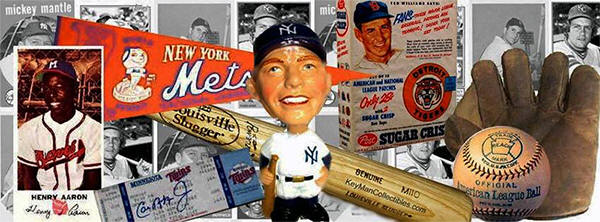|
1907 Reach Patent
Elastic Head
Strap |
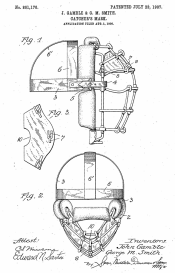 |
|
Made with Loop & Clip Construction |
|
|
1911 D & M Electric Weld Steel
Wire Catcher's Mask |
 |
|
Google Eye AKA
"Spiderman" eye space |
 |
"V" Style
Forehead
Truss construction |
|
"Wide Vision"
"U" Style Forehead |
 |
Truss Construction
with a Diamond Spitter |
|
| WELCOME ALL ! |
 |
Baseball Collectibles
and Memorabilia |
|
|
|
| KeyMan
Collectibles |
NEWSLETTER |
April 2016 |
|
|
The Evolution of Features & Design used
to Date a |
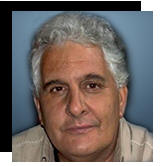 |
|
Steven KeyMan |
|
|
Catchers Mask
-
By Steven KeyMan |
|
Founder of
Keymancollectibles.com,
and a long time
collector, Steven
KeyMan has more than 30
years of experience in
researching, and
cataloging information
on Baseball
Memorabilia. First used
for his own personal
collection, and then by
helping others find
information on their
collectibles, the
website grew into the
largest online resource
for baseball
memorabilia |
|
|
|
|
|
| |
Ask
Steven: Direct your questions or feedback,
about Baseball Memorabilia to Steven KeyMan
Steve@keymancollectibles.com You can also Send
KeyMan pictures of your personal Memorabilia Display,
and get your own Free
Collectors Showcase Room featured on the website.. |
|
|
|
|
| |
Modeled after a fencing mask in 1876,
Fred Thayer commissioned a local
tinsmith to create the first catchers
mask. Resembling a birdcage the mask
worn by Thayer on April 12th, 1877, was
the first to be used in a professional
baseball game. Fred Thayer was granted a
patent on the mask in 1878, and would officially mark the evolution of
catchers mask design.
officially mark the evolution of
catchers mask design.
The first retail catchers mask was made
available by Spalding in 1877. In a
1880 advertisement, Spalding warns
catchers not to trust their face to a
cheaply made mask. "..liable to
disfigure a player for life."
Spalding's No.0 catchers mask was made
with "Extra heavy wire, well padded
with goathair and the padding faced
with the best imported dogskin, (yes,
Dogskin) which
is Impervious to perspiration and
retains it's pliability and softness."
Three Grades were manufactured. Professional, Amature, and a Boys
model.
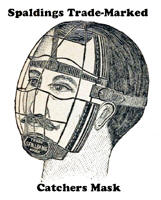 The
Dating of a catcher's mask could prove
to be a difficult task. Construction
styles, materials, and features could
have been used for many years after
they were first introduced. Loop & clip
construction was used throughout the
1880's and 1900's. Starting in 1911
electric weld construction was
introduced but
the loop & clip method was still used
into the early 1920's. Features are not
replaced over night, most are gradually
phased out. The
Dating of a catcher's mask could prove
to be a difficult task. Construction
styles, materials, and features could
have been used for many years after
they were first introduced. Loop & clip
construction was used throughout the
1880's and 1900's. Starting in 1911
electric weld construction was
introduced but
the loop & clip method was still used
into the early 1920's. Features are not
replaced over night, most are gradually
phased out.
|
|
| |
There were many experiments with
catcher's mask design in the early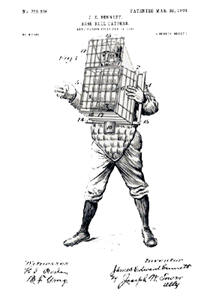 1900's. Some did not catch on like this
1904 patented "baseball catcher" - You
don't need a catcher's mitt or a mask
with this nifty invention and you could
probably use it to go crabbing after
the game. !! The chest cage was
designed for the ball to go through the
gates in the front, and stopped by the
springs in the back of the cage. The
ball came out the bottom, and had a
wire mesh extension to protect the
catchers face.
1900's. Some did not catch on like this
1904 patented "baseball catcher" - You
don't need a catcher's mitt or a mask
with this nifty invention and you could
probably use it to go crabbing after
the game. !! The chest cage was
designed for the ball to go through the
gates in the front, and stopped by the
springs in the back of the cage. The
ball came out the bottom, and had a
wire mesh extension to protect the
catchers face.
However, many innovative designs did catch on and are still being used
today. In 1907 Reach introduced the
elastic head straps. Before this time,
all leather or and canvas was used.
"The Spitter" hole was introduced in
1914, and shortly after the use of
truss support & double wire
construction. Umpire James E. Johnstone,
patented a one piece aluminum frame in
1921, and another in 1924. The intention
was to make the mask
lighter, and reduce construction time
and cost. The one piece cast
(magnesium) frames did not start to catch on
until the 1940s, and became more common
in the 1950s. |
|
| |
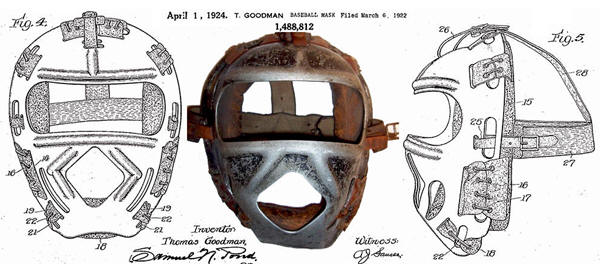 |
|
| |
Early
masks were designed with a "molded"
chin rest that consisted of a simple
piece of leather. It was not until
about 1914 when chin pads filled with
horse hair hit the market. By the
1920's full length "Adjustable" face
padding laced to the frame is now
becoming the norm. Previous to the use
of lacing,
 wire was used to secure the
pads to the frame. Padding laced to the
frame, will carry over into the 1950's
until manufactures start to use snap on
pads. wire was used to secure the
pads to the frame. Padding laced to the
frame, will carry over into the 1950's
until manufactures start to use snap on
pads.
The 1940's
carry on with the mask designs from the
1930's with double and triple carbon
steel wire, truss construction frames,
but made broader. Both the heavy wire,
and one piece cast frames, feature two
eye bars for "Open" or "Clear Vision." A
single bar going across the face, and
the other at the forehead. The "Google
Eye" AKA "Spiderman" eye space was left
behind in the 1920's, although they do
occasionally show up in the market
until 1942, mostly used with "Boy's
models" |
|
| |
|
|
| |
Catchers Mask Features &
Designs Visual Glossary |
|
| |
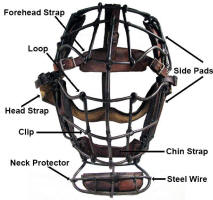 |
 |
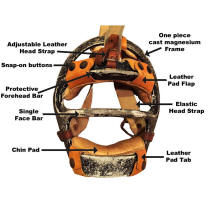 |
Circa 1890-1910s
Goggle Eye or "Spiderman"
style catchers mask |
1916-1920s Electric Weld
catchers mask with Diamond
Spitter |
1950's One Piece Cast Magnesium
catchers mask with Snap-On
Padding |
|
|
| |
|
|
| |
For more information visit the
Vintage Catchers Mask Dating Guide.
This guide features a timeline and a
decade by decade guide for dating your
vintage catchers mask. The guide
includes catalog images so you can
match styles and construction
characteristics like a fingerprint. |
|
| |
|
|
| |
KEYMAN COLLECTIBLES
RELATED RESOURCES |
|
| |
|
|
| |
 |
|
| |
|
|
| |
KeyMan
Collectibles Collectors Corner
- Keep up with the latest collecting news,
announcements, and articles of interest on the
webs best resource for baseball memorabilia. |
|
| |
Collectors Showcase - Half
the fun of collecting is showing it off to
others. Send KeyMan Collectibles pictures of
your Memorabilia Room or Display, and get your
own Free Collectors Showcase Room. |
|
| |
KeyMan Collectibles Baseball
Memorabilia Facebook Group -
Post Questions and comments relating to
Baseball Collectibles and Memorabilia. Interact
with other collectors or show off your
collection. |
|
| |
KeyMan Collectibles Network54 Forum
- A great option for those that "Don't do
facebook" Post Questions and
comments relating to Baseball Collectibles and
Memorabilia |
|
|
|
|
|
|
|

